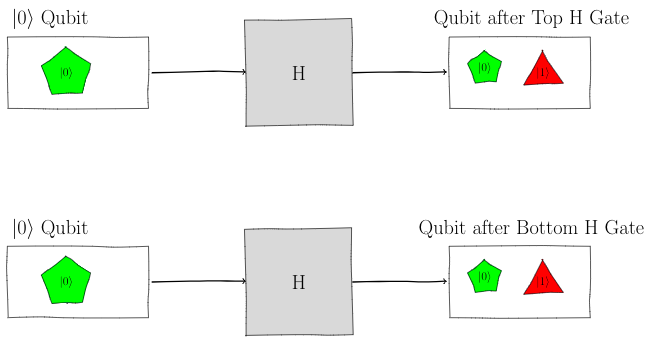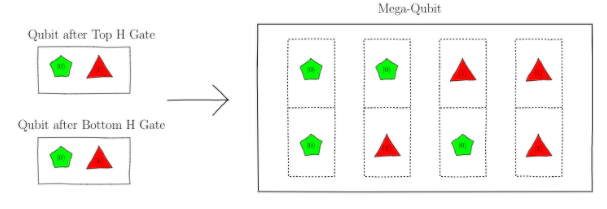Superposition
The H gate takes a pure qubit — $\ket{0}$
or $\ket{1}$ —
and splits it putting the qubit in a quantum state that now
contains both pentagons and triangles — a
quantum state that is a superposition of
two different qubelets.
Splitting two qubits considerably thickens the plot.
Unlike classical computers where operations on one
bit doesn't affect others in the system,
in quantum computing an action on one influences
the states of others. To handle this characteristic
of quantum bits, we must think of all possible states
of the quantum bits at once instead of the classical way
of thinking of one-bit-at-a-time approach.
To help us get comfortable with
this shift in mindset, consider the following circuit in
which two qubits are split as follows:

Each H gate splits the $\ket{0}$ qubit. But, in quantum
computing, you don't treat these split pentagons and triangles
as individual units. Rather, each shape in the top
qubit pairs up with each shape in the bottom qubit forming the
four combinations as shown below:

These combinations, called qubelet
combinations, form a mega-qubit.
If we feed the mega-qubit to other gates, then those
gates operate on all the combinations in the mega-qubit
simultaneously.
When more qubits are split, the mega-qubit automatically holds
the combinations formed from the pentagons
and triangles from all the split
qubits. For example, when 3 qubits are split by
the H gate, the resulting mega-qubit is shown
below:

Each combination is formed by taking a shape from
each of the three qubits in turn. This gives
$2 \times 2 \times 2 = 2^3 = 8$ combinations in the
mega-qubit on the right in the above figure.
In general, as the number of qubits you split becomes large, the
number of combinations in the mega-qubit becomes astronomical and
well beyond the means of classical computers. But, this gigantic
increase in complexity has no impact for quantum computers which
is hard-wired to deal with all combinations simultaneously
regardless of how many there are.
This ability to simultaneously deal with all
combinations or possible quantum states of the
qubits offers a spectacular way to routinely solve
industrial-scale applications that even today's
supercomputers find impossible to tackle: in a quantum
computer all Boolean operations are applied to
possible states at the same time unlike a
classical computer in which only one combination of
states at a time are operated on.
One of these combinations, the solution to your problem,
is lurking in the mega-qubit. The goal in designing a
quantum algorithm is to apply quantum gates to the qubits to
tease this solution out from the all the other combinations.
In the next section, you'll
learn that the qubelets model explains entanglement,
another quantum phenomena that has no classical counterpart.
Where to learn more
The material in this section has been adapted from Chapter 4 of my book. In this chapter, you'll also learn how to write a quantum program for the concepts you've learned about here.